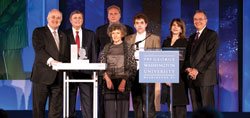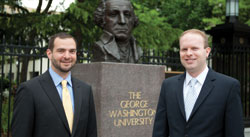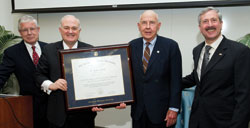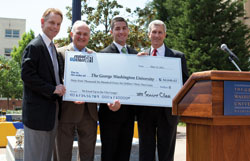Donors and Community Members Celebrate Smith Center Transformation

(From left) President Steven Knapp, Robert P. Kogod, GW Trustee Randy Levine, BA '77, Clarice Smith, David Bruce Smith, Michelle Smith, and GW Trustee Mark Hughes
Supporters of the Charles E. Smith Center gathered at the GW landmark May 3 to celebrate the center's multimillion-dollar transformation and the benefactors who made it possible.
At the celebration, GW President Steven Knapp announced that more than $21.1 million had been raised for the athletic complex to date. Fundraising efforts began in 2008 with a $10 million challenge from the Robert H. Smith Family Foundation, the Charles E. Smith Family Foundation, and Robert P. and Arlene R. Kogod. The gift, a one-to-one challenge match, was the catalyst for donors to contribute more than $11 million to the project.
Renovations to the signature building in the heart of campus include a refurbished arena, locker rooms, training and sports medicine facilities, an on-site academic center, a new box office, refreshment areas, and a Colonials Club. Designed by architectural firm Gensler and managed by Whiting-Turner Contracting, the transformed Smith Center will set a new architectural and aesthetic standard for future university buildings.
"I'm very delighted to welcome you to this fabulous celebration of a truly marvelous project at the George Washington University," President Knapp said at the event. "As you can see around you tonight, the transformation has yielded spectacular results."
Current and former GW trustees—including New York Yankees President Randy Levine, BA '77; Mark Hughes, BA '69, MS '77; David Bruce Smith, BA '79, grandson of the center's namesake Charles E. Smith; and Tad Lindner, BA '51—joined President Knapp and Senior Vice Provost and Vice President Robert Chernak to unveil donor plaques and recognize the past and future of GW athletics. Among those being honored were Robert P. and Arlene R. Kogod, Clarice Smith, widow of Robert H. Smith, and their son, David Bruce Smith.
Named after the late Charles E. Smith, a GW trustee and honorary degree recipient who provided the initial gift to build the facility in 1975, the center houses GW's Department of Athletics and Recreation, which supports 22 NCAA teams, club sports, recreational activities, and related academic programs. The complex hosts the university's Freshman Convocation and individual school commencement celebrations. Popular entertainers such as Billy Crystal, Robin Williams, and Jimmy Fallon have also performed at the Charles E. Smith Center.
During the celebration, a video chronicling the transformation of the GW landmark was shown. Members of the GW community, including student leaders and athletes, varsity coaches, Associate Athletic Director for Facilities Jason Wilson, BS '96, and Foggy Bottom community representative Theo Shepard spoke about the impact of the new athletic facility. Although fundraising efforts for the project are not yet complete, the amount so far is the most ever raised for a single project at GW.
For additional information on the Charles E. Smith Center transformation, visit go.gwu.edu/charlesesmithcenter.
GW's Homeland Security Policy Institute Examines U.S. Resiliency, Thanks to ICF Grant

Keith Stefanelli, disaster resilience scholar with ICF International and HSPI, and Daniel Kaniewski, co-chair of the task force and assistant vice president and deputy director of HSPI.
A $100,000 grant from ICF International will support a special task force at the GW Homeland Security Policy Institute. The HSPI Preparedness, Response & Resilience Task Force, a group of 14 emergency experts, will offer specific policy recommendations for making the government and the public more resilient.
Resiliency, defined by the White House as the ability to adapt to, prepare for, withstand, and rapidly recover from disruptions from terrorism, natural disasters, large-scale cyber attacks, and pandemics, includes everything from a building's ability to withstand an earthquake to a community's recovery from natural or manmade disasters.
"ICF's support of our Preparedness, Response & Resilience Task Force will enable us to delve into resilience policy issues heretofore not considered," says Daniel Kaniewski, co-chair of the task force and assistant vice president and deputy director of HSPI. "I am convinced that the task force is well-positioned to serve as a thought leader on these issues."
ICF International, a professional services firm that partners with government and commercial clients to provide strategy, policy analysis, program management, and evaluation, is a longtime sponsor of GW's Homeland Security Policy Institute. John Paczkowski, ICF vice president, says he believes his organization's support for HSPI will benefit the entire homeland security community.
"We are committed to advancing the cause of national resilience and a whole-of-nation approach to homeland security. ICF shares HSPI's commitment to candid and unbiased analysis of homeland security issues and its unwavering support to our nation's elected leaders and policymakers as they address emerging threats to the homeland," Mr. Paczkowski says. "We are very proud of our relationship with the George Washington University and in particular the Homeland Security Policy Institute."
Visit the Homeland Security Policy Institute at www.gwumc.edu/hspi.
A Provost and Professor
Provost Steven Lerman delivers lecture on digital labs at his investiture as the James Clark Professor.

(From left) Dean of the School of Engineering and Applied Science David Dolling, President Steven Knapp, A. James Clark, and Provost Steven Lerman
During his opening remarks at the investiture of Provost Steven Lerman as A. James Clark Professor of Civil and Environmental Engineering, GW President Steven Knapp delivered a brief history of endowed chairs at the university.
The oldest endowed chair at GW dates back to 1832, when an act of Congress created the Congressional Professorship. In 1872, a bequest from Romeo Elton of Exeter, England, formed the Elton Professorship of Mental and Moral Philosophy.
"This afternoon, we're delighted to continue this tradition with the installation of Dr. Lerman as the second A. James Clark Professor of Civil and Environmental Engineering," Dr. Knapp said, as the first Clark Professor Gideon Frieder looked on.
Chairman of the Board and CEO of Clark Enterprises A. James Clark, who received an honorary doctorate of engineering at last year's Commencement ceremony, endowed the professorship in 1986. Earlier this year, Mr. Clark, who attended the investiture with his wife, Alice, created the Clark Engineering Scholars program in the School of Engineering and Applied Science.
After Dr. Knapp and David Dolling, dean of the School of Engineering and Applied Science, read citations and presented a medal to Dr. Lerman, the provost delivered a lecture titled, "iLab: Innovations in eLaboratory Software," which focused on a project he worked on at his former institution, the Massachusetts Institute of Technology. The iLab program, which began before the word "Internet" was popularized, connected undergraduate students with experiments at labs at universities across the globe.
2011 Senior Class Day Celebration

(From left) Board of Trustees Chairman W. Russell Ramsey, BBA '81, President Steven Knapp, Senior Class Gift Campaign Coordinator Eric Thibault, BA '11, and board member Steven Ross, BBA '81, hold the class gift check at the 2011 Senior Class Day Celebration shortly before receiving a $13,000 anonymous gift to the Senior Class Gift Campaign.
At a May 12 celebration in Kogan Plaza, surrounded by hundreds of members of the class of 2011, Senior Class Gift Campaign Coordinator Eric Thibault, BA '11, presented Board of Trustees Chairman W. Russell Ramsey, BBA '81, GW board member Steven Ross, BBA '81, and GW President Steven Knapp with this year's Senior Class Gift. Totaling more than $89,000, the 2011 Senior Class Gift surpasses the amounts raised in the previous four years of the Senior Class Gift campaigns, thanks in part to a last-minute anonymous gift of $13,000.
More than 40 percent of the class of 2011—the highest giving rate ever—participated by giving to the school, program, organization, or other part of the university that meant the most to them. The total included a matching gift from the Luther Rice Society, which will be designated to the Ron Howard Emergency Scholarship Fund. The fund supports financial awards to full-time undergraduate students who are active in leadership or extracurricular activities at the university and who have emergency or other financial needs that are not met through traditional financial aid. The fund was chosen by the senior class earlier in the year.
"A tradition at GW since the 1980s, the Senior Class Gift is a way for each class to leave an imprint on the university," Mr. Thibault says. "This year we had the unique opportunity to create a legacy as distinct and diverse as our class by giving back to the areas of the university and organizations of our choice."




